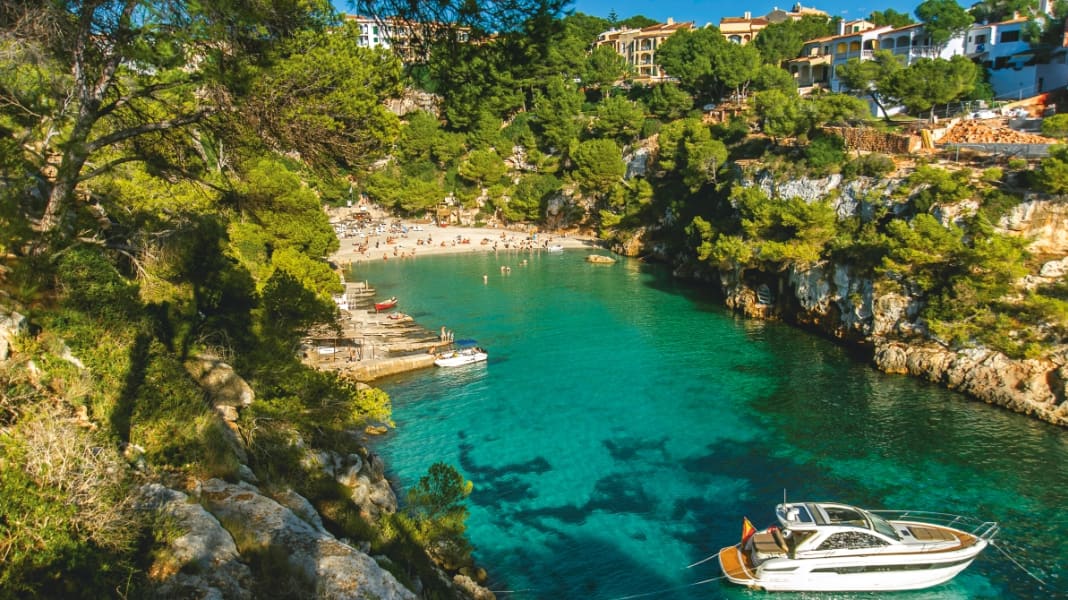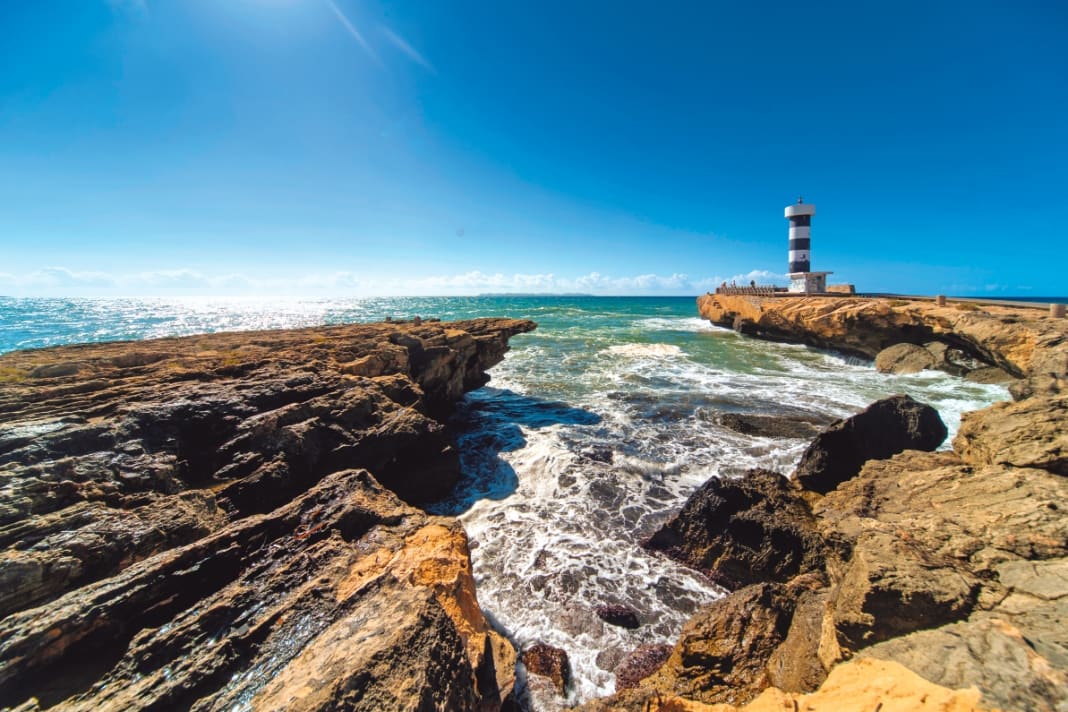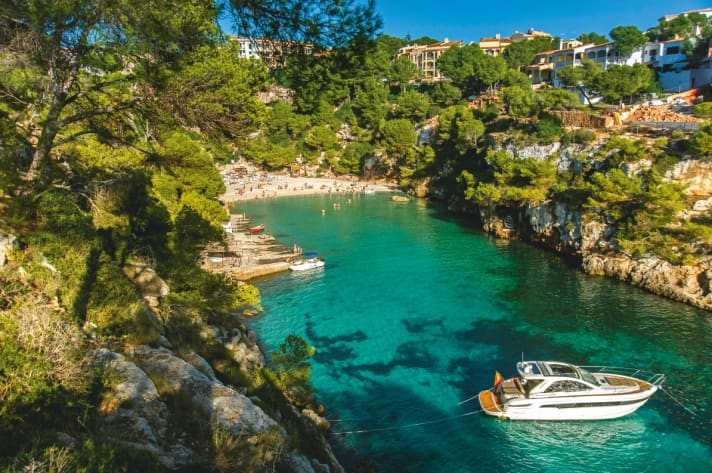
If you are planning a Balearic cruise and want to explore all five inhabited islands - Mallorca, Ibiza, Formentera, Cabrera and Menorca - you have a lot to do. Definitely too much in just one charter week, because the islands in the western Mediterranean have a lot to offer. But lack of time is not the only limitation.
Depending on the time of year and weather conditions, not every route can be travelled comfortably at all times. We experienced this on our trip in autumn 2014, but more on that later. The "España Emotion", a Bavaria Sport 39 HT, was waiting for us at the Club de Mar in Palma de Mallorca. The interior of the well-maintained charter yacht, which is operated by Horst Ellerbrock's young company Premium Charter SL, is luxurious. Nothing is missing.
There is even a hydraulic bathing platform and the air conditioning ensures pleasant temperatures below deck even in the middle of summer. However, comfort is not only provided on board, the provider also scores highly in terms of service. When we board the boat, the shopping we ordered is already on board. It couldn't be more convenient. This saves time and effort - after all, there are better things to do on a week-long cruise than lugging food and drinks from the supermarket to the boat.
The crossing to Ibiza is planned for the next morning. We have been observing the weather for some time, as not everything always goes according to plan when travelling by sea, and not just in the early and late season. But we are lucky. Apart from a minor disturbance, which is expected the night after next, everything goes according to plan. In addition to two stops on Ibiza, Formentera is on the wish list.
Cala Pi on Mallorca and the Cabrera Nature Park are planned for the return journey. Authorisation is required to call at Cabrera, and a mooring is allocated for a specific day. Deviations are not possible. The charter company also takes care of this for the customers. So all we have to do is set off. The next day greets us with glorious sunshine and barely visible waves. A perfect start.
Our first destination is Ibiza Town. At 75 nautical miles, this is the longest beat we will cover. At an optimum cruising speed of 23 knots, this would be doable in around 3.5 hours. But we still want to take a look at the small private island of Tagomago, which belongs to the German entrepreneur Matthias Kühn. If you want to really let it rip, you can rent the mostly uninhabited island and the villa there.
Cruising guides speak of six-figure sums per week. However, the yacht can also anchor in the small bay on the west side and have a drink in the beach bar. This is considerably cheaper. However, the anchorage doesn't seem very safe and there's no-one in the bar. So we continue to glide leisurely along the beautiful coast of Ibiza, which begins just half a nautical mile west of Tagomago. It takes us a while to reach our destination, as we have still explored the bay near Santa Eulalia, which we want to visit on the way back, and Cala Longa, which is a good place to stop for a swim or - with the exception of easterly winds - to spend the night.






Ibiza Town can be recognised from afar by the mighty fortress at the entrance. The choice of four marinas in the spacious bay seems large at first glance, but appearances are deceptive. In summer, it's a real madhouse here and moorings can only be booked in advance (preferably in February). The prices are correspondingly high and are constantly rising. Especially in Ibiza Town, you can expect to pay 300 euros per night for a 12-metre yacht at the time of your trip.
Although we would have a good chance of finding a berth a little closer to the city centre in mid-October, we try the Marina Botafoch (www.marinabotafoch.com), which is located directly behind the cruise terminal, opposite the city. At this time of year, there are plenty of spaces even without a reservation and the harbour master immediately allocates us a place. At €41, which we are charged for the overnight stay including additional costs, we get away relatively cheaply. We consider the long walk into town, which takes about half an hour, to be a walk in the park. The approximately 2700-year-old settlement was founded by the Phoenicians. The citadel, which is adjoined by the old town with its winding alleyways, was built by Moors between the 9th and 13th centuries and has been a UNESCO World Heritage Site since 1999. We take a leisurely stroll through the impressive ambience with its countless shops and pubs. Some of them are already taking a winter break, as the biggest tourist rush is over.
While looking for dinner in a cosy atmosphere, we come across the small restaurant La Scala (www.la-scala.com) right next to the fortress. We are lucky to get the last remaining seats on the idyllic terrace. The food is delicious, the service is excellent and the price is reasonable.
We had already noticed the freshening wind in the evening, knowing full well that a small disturbance was due to blow through during the night. So it's hardly surprising that we encounter some waves at the harbour exit the next day. Nevertheless, we set off on the short 12-nautical-mile journey to Formentera. We could always turn round and call at Santa Eulalia as an alternative. It was also clear that the wave coming from the west would increase the closer we got to the narrow passage between the islands. With a maximum water depth of 10 metres, it is quite shallow here.
The steep drop towards the west to 600 metres then shows its effect behind the narrow passage, as we are suddenly confronted with a wave height of almost two metres. Only four nautical miles separate us from our destination. If the weather was good, almost everyone would go to one of the numerous murings in the marvellous Badia de s'Alga anchorage off Espalmador or Cala Sabina in Formentera. But the bays are all open, which is only possible in perfect weather. Our only option is to spend the night in the marina Formentera Mar (www.formenteramar.com), which is located in the Puerto de la Savina. Riding the wave requires a change of course, as it is not possible to head straight for the harbour. Due to the short distance, this was still acceptable, but working the throttle requires full concentration.
It was clear that only the kitesurfers were having fun today, but hardly anyone dared to go here in these conditions. The space available in the harbour is correspondingly large. In the afternoon, a Lagoon 440 arrives, for which the small waves pose no challenge. That was it. Just under 44 euros are charged for an overnight stay with additional costs. In midsummer 2014, a whopping 220 euros were due according to the price list.
The fact that the season is over and the former hippie stronghold is somewhat removed from the mainstream is not only evident from the prices. The regularly arriving ferries still spit out day tourists, but the hope of enjoying dinner in one of the well-known fish restaurants located on the sandy beach in front of the Muringfeld is quickly buried.
The well-known fish restaurant Es Molí de Sal (www.esmolidesal.es) on the northern tip of Formentera has long since taken its winter break. Only the cool shark bar Tiburon (www.tiburon-formentera.com) still attracts a few guests. We also treat ourselves to a beer in the very original ambience among the conifers and enjoy the marvellous view and the sound of the waves on the seemingly endless white dream beach with a South Sea feeling. There is little choice for dinner. The grilled octopus at Restaurante Bellavista, right in the harbour, is delicious.
The next stage takes us back to Ibiza. The Santa Eulalia marina (www.puertodeportivosantaeulalia.com) is quickly reached after just 18 nautical miles. To be on the safe side, we fill up with 400 litres of diesel so that the tank is full again. In hindsight, the first fill, including the safety reserve, would have been enough for the entire trip. There is plenty of space for guest berths and the price of less than 32 euros for the night is comparatively moderate. In summer - like everywhere else - it's a different story. Nevertheless, the marina is known to be good value for money and is often favoured as an alternative to Ibiza Town.

The location here is cheaper and the 16 kilometres by taxi are quickly covered for a visit to the capital. A tour of the tourist resort makes it clear that the low season is still in full bloom here. Holidaymakers are streaming out of the numerous hotel complexes and the beaches are busy. Although you can also dine excellently in the marina's cosy restaurants, we plunge into the hustle and bustle of the narrow streets of the old town in the evening. Bars and restaurants are a dime a dozen here, all are well frequented and we are very satisfied with our intuitive choice.
The next morning, the crossing back to Mallorca is on the programme. In glorious weather and perfect conditions, we glide the 66 nautical miles comfortably in three hours to Cala Pi. In the small but very idyllic bay with its steep cliffs, there are only a few anchorages, most of which are occupied by sailors. But we are faster with the motor yacht and arrive in the early afternoon.
There are only a few small motorboats around to stop for a swim and, thanks to the shallow draught, we grab the shallow but better protected anchorage directly in front of the sandy beach.
There are a few things to bear in mind when anchoring. The iron must be thrown into one of the light-coloured sand areas so that it holds. After the manoeuvre, I check the position with my diving goggles during a refreshing swim in the crystal-clear water. Then I always secure the boat with a stern line to one of the rocks, because the bay is narrow and swinging around the anchor chain in changing winds would be fatal. If everything is in order, the anchorage here is good and safe unless the wind or swell is pushing into the bay.
The anchor manoeuvre is rewarded with a wonderful location. There are several restaurants in the tiny village where - as is usually the case on the Balearic Islands - a delicious dinner awaits. We opt for Restaurante Miguel right on the cape and have an excellent meal here too. Don't forget a torch, as the way back after the steep footpath across the beach is pitch dark and the path to the dinghy is difficult to recognise due to the numerous tripping hazards on the old boat sheds.
A visit to Cabrera is the final destination the next day. As the 14 nautical miles are travelled quickly and the buoys don't have to be released for the next overnight stay until the afternoon, we spend the morning in the beautiful Cala Pi and don't set off on the short crossing until the afternoon.
When we enter the bay of Cabrera, our berth is free. The buoys have different colours. They are white for boats up to 15 metres. The price for the permit is 15 euros per night. In July and August, a maximum of two nights are permitted, otherwise five. Self-catering is the order of the day here, as there are no restaurants, just a small bar that now also serves tapas. Fresh fish can be bought from fishermen on the pier. We savour the home-cooked food, which is eaten in the open air on board, to the full. And you can relax and unwind here by bathing in the sun or in the clear water.
As the journey to the home harbour is short, we decide to sail to the beautiful sandy beach of Es Trenc in Mallorca the next morning and anchor there after 11 nautical miles. In calm weather, the open bay is perfect for a swim. The dinghy is launched for the shore leave. It is worth visiting the saltworks (www.flordesaldestrenc.com) or the tourist centre of Sant Jordi. Both destinations can be reached after a two-kilometre walk. Salt production has a long tradition on the Balearic Islands. Flamingos can be observed in the evaporation pools on the way to the salt works.
After a lunch in the cosy harbour atmosphere of Sant Jordi - the marina there is mainly used by locals and fishermen, guest places are rare - the last 25 nautical miles to Palma de Mallorca lie ahead of us in the late afternoon, and we are really looking forward to exploring the rest of the Balearic Islands on another trip with the "España Emotion". The report will follow.

